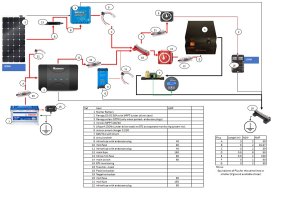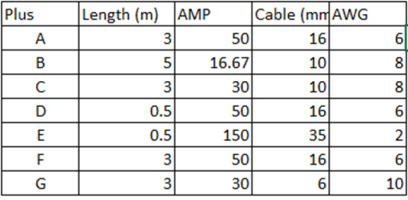That’s in the realm of Dellmassive and others. I can only give anecdotal evidence on my real life use case.this potentially chan
This potentially changes the requirements slighly, and means I can add other things instead but would need to check.
Just another element on the diagram - BMV 712 and shunt - is it needed knowing roamer or fogstar have their own BMS system to monitor similar parameters? thx
You are using an out of date browser. It may not display this or other websites correctly.
You should upgrade or use an alternative browser.
You should upgrade or use an alternative browser.
Seeking Feedback on Electrical Diagram for my project
- Thread starter ArtD
- Start date
-
- Tags
- camper electrics
Popular choice is to use a Victron Smart Shunt to get an overall view of energy usage.
1 AWG is a 50mm2 cable - that seems remarkably large to feed a 50A fuse box?
worst case scenario 50A at 3m length (perhaps I'm very risk revers here)1 AWG is a 50mm2 cable - that seems remarkably large to feed a 50A fuse box?
Can you show your calculations?
That cable is normally rated at around 350 amps - I'd only expect that to be used to strap batteries together or extremely high power inverters.
That cable is normally rated at around 350 amps - I'd only expect that to be used to strap batteries together or extremely high power inverters.
@Dellmassive - do you think I would be able to fit roamer 230Ah under seat togethre with renogy dc-dc 50A or would be to much of the push?
Why are you mixing Renogy & Victron kit? I’d go one or the other (Victron) if only for the superb APP integration & quality kit.@Dellmassive - do you think I would be able to fit roamer 230Ah under seat togethre with renogy dc-dc 50A or would be to much of the push?
The new Renogy IP65 dc-dc charger looks like it will fit.@Dellmassive - do you think I would be able to fit roamer 230Ah under seat togethre with renogy dc-dc 50A or would be to much of the push?
The normal Renogy dc50 MPPT may fit.... But you might need to tweek the seat base .....
Have a look at my Roamer and Fogstar pages to see the space available.
@Dellmassive, please advise whether it is possible to connect victron 12/30 through the same cable as starter battery to dc-dc and use the charger when engine switched off only. I want to minimise no of cables run through car boot but having option to: 1. connect starter battery to renogy dc-dc, 2. connect victron charger, 3. connect PV panel. I know that no3 needs to run to different connection within dc-dc so separate cable needed but wonder whether no2 can be done through no1?
thx
thx
12/30? - as in the IP22 12v/30a/1op EHU charger?
if you mean can you connect the EHU 12v charger output to the same point/terminal as at the DC-DC starter input connection in the rear. - then yes.
.........
assuming, you have one Fused POS cable from the starter battery to the rear,
at the rear you connect the DC-DC "starter side" and EHU charger and use chassis as the NEG return to the starter battery. ( this EHU charger to be used when engine OFF and static on EHU feed)( the starter battery will be charged, and if the DC-DC charger supports the feature, it will wake up and start charging the LB as well - Auto VSR)
i would fuse the EHU charger at the connection point of the DC-DC charger to protect the charger cable. as the main feed will be 60A odd with fat cable and the 30A charger will have much thinner cable - so needs fusing down.
if you mean can you connect the EHU 12v charger output to the same point/terminal as at the DC-DC starter input connection in the rear. - then yes.
.........
assuming, you have one Fused POS cable from the starter battery to the rear,
at the rear you connect the DC-DC "starter side" and EHU charger and use chassis as the NEG return to the starter battery. ( this EHU charger to be used when engine OFF and static on EHU feed)( the starter battery will be charged, and if the DC-DC charger supports the feature, it will wake up and start charging the LB as well - Auto VSR)
i would fuse the EHU charger at the connection point of the DC-DC charger to protect the charger cable. as the main feed will be 60A odd with fat cable and the 30A charger will have much thinner cable - so needs fusing down.
Yes I mean victron smart charger 12v/30A to be connected either:12/30? - as in the IP22 12v/30a/1op EHU charger?
if you mean can you connect the EHU 12v charger output to the same point/terminal as at the DC-DC starter input connection in the rear. - then yes.
.........
assuming, you have one Fused POS cable from the starter battery to the rear,
at the rear you connect the DC-DC "starter side" and EHU charger and use chassis as the NEG return to the starter battery. ( this EHU charger to be used when engine OFF and static on EHU feed)( the starter battery will be charged, and if the DC-DC charger supports the feature, it will wake up and start charging the LB as well - Auto VSR)
i would fuse the EHU charger at the connection point of the DC-DC charger to protect the charger cable. as the main feed will be 60A odd with fat cable and the 30A charger will have much thinner cable - so needs fusing down.
Option 1. through fuse box (to main cable from starter to renogy dc-dc 50V charger)
Option 2. directly connected to starter (feed cable with anderson plug and fuse at 40A) - my preference if feasible
no EHU but just regular plug (or if needed ehu with regular plug at the end to connect victron)
so when engine is off the charger is charging LB (I would manually plug anderson feed with fuse) and when driving alternator will charge through dc-dc.
Just not sure whether renogy dc-dc would take it - it says smart VSR or precisly '
Built-in Voltage Sensitive Relay (VSR)
When connected with two batteries, it is vital to be able to isolate the two start and service batteries for charging safety. Renogy Dual Input DC-DC On Board MPPT Battery Charger with its built-in VSR allows vehicle owners to enjoy the benefits of fully charged deep cycle service batteries while reliably isolating it to the engine starting battery with one easy-to-install charging system.'
but not sure whetehr it is auto VSR as you refer to (no smart alternator)
gotcha,
yes option 2 is ok.
and yes the RENOGY DC50S has the "Auto VSR feature"
++++++
so when parked with engine off. . . you connect the Victron EHU charger 12/30/1 - via your 40A fused Anderson SB50 connector.
it will start charging the starter battery,
when starter battery rises above 13.8v or so,
the Renogy dc-dc will switch on and start charging your LB.
the Victron is a great charger for this setup as you can "tweak" the charge voltage. . . as in some chargers have some volt drop over the connection, and the dc-dc charger wont kick in, with the Victron you can tweak the charge profile and UP the charge voltage a bit.
++++++++
i show it in action over here:

 www.t6forum.com
www.t6forum.com
.
engine OFF, and charger plugged in. . .
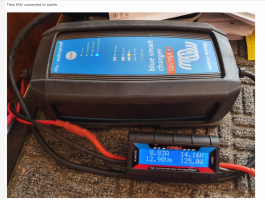
+
Renogy DC-DC sees voltage rise, and turns on - which starts charging the LB.
+
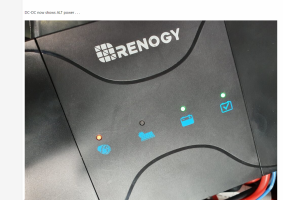
both batterys get charged,
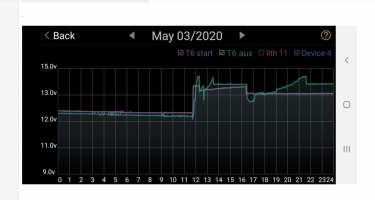
yes option 2 is ok.
and yes the RENOGY DC50S has the "Auto VSR feature"
++++++
so when parked with engine off. . . you connect the Victron EHU charger 12/30/1 - via your 40A fused Anderson SB50 connector.
it will start charging the starter battery,
when starter battery rises above 13.8v or so,
the Renogy dc-dc will switch on and start charging your LB.
the Victron is a great charger for this setup as you can "tweak" the charge voltage. . . as in some chargers have some volt drop over the connection, and the dc-dc charger wont kick in, with the Victron you can tweak the charge profile and UP the charge voltage a bit.
++++++++
i show it in action over here:

[Guide] DC-DC Charger (for leisure battery) -- How I Done It --
@Farnorthsurfer did you set the Dc-dc to lithium mode for the TN100 battery? Also have you got any more BM2 views showing more days? Yes the unit is set to Lithium profile. Easy enough to do when it was powered up. Yesterday was a flat line all day as it just sat on the drive. Back to work...
.
engine OFF, and charger plugged in. . .

+
Renogy DC-DC sees voltage rise, and turns on - which starts charging the LB.
+

both batterys get charged,

Could I ask why the Anderson connector is needed here and why you couldn't just leave it plugged in?
using charger for other stuff too so make it cheaper (perhaps not easier)Could I ask why the Anderson connector is needed here and why you couldn't just leave it plugged in?
Similar threads
- Replies
- 46
- Views
- 2K
- Replies
- 37
- Views
- 1K
- Replies
- 4
- Views
- 168
- Replies
- 4
- Views
- 455

